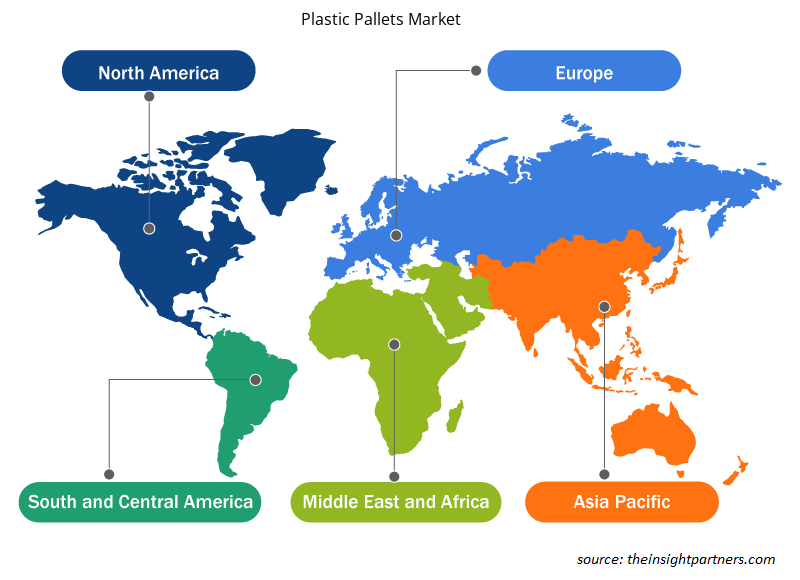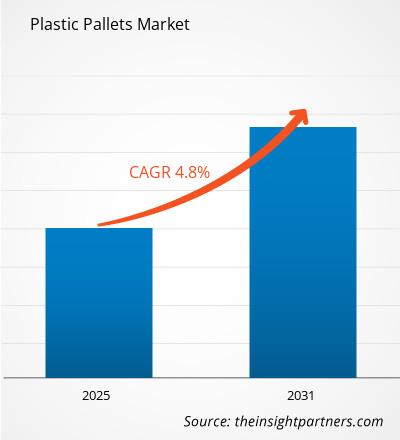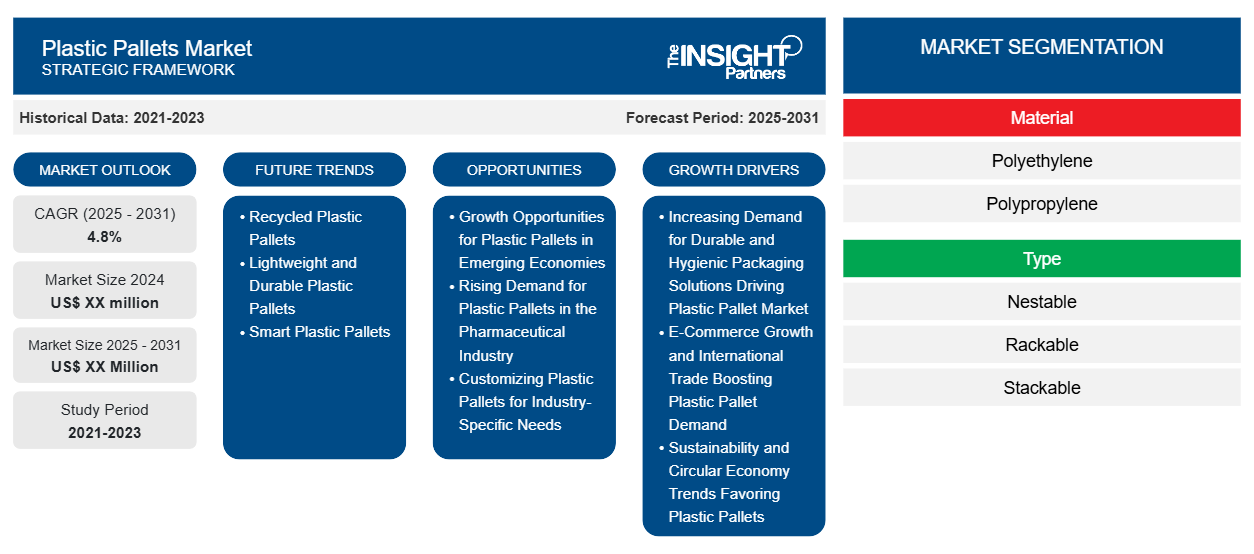Si prevede che il mercato dei pallet in plastica registrerà un CAGR del 4,8% dal 2023 al 2031, con una dimensione di mercato in espansione da XX milioni di dollari nel 2023 a XX milioni di dollari entro il 2031.
Il report è segmentato per materiale (polietilene, polipropilene e altri). Il report è ulteriormente segmentato per tipo (annidabile, montabile su rack, impilabile e altri). Il report è segmentato per uso finale (cibo e bevande, prodotti chimici, petrolio e lubrificanti, prodotti farmaceutici, automotive, edilizia, vendita al dettaglio e altri). L'ambito del report copre cinque regioni: Nord America, Europa, Asia Pacifico, Medio Oriente e Africa e Sud e Centro America e paesi chiave in ciascuna regione. L'analisi globale è ulteriormente suddivisa a livello regionale e nei principali paesi. Il report offre il valore in USD per l'analisi e i segmenti di cui sopra.
Scopo del rapporto
Il report Plastic Pallets Market di The Insight Partners mira a descrivere il panorama attuale e la crescita futura, i principali fattori trainanti, le sfide e le opportunità. Ciò fornirà spunti a vari stakeholder aziendali, come:
- Fornitori/produttori di tecnologia: per comprendere le dinamiche di mercato in evoluzione e conoscere le potenziali opportunità di crescita, consentendo loro di prendere decisioni strategiche informate.
- Investitori: condurre un'analisi completa delle tendenze in merito al tasso di crescita del mercato, alle proiezioni finanziarie del mercato e alle opportunità esistenti lungo la catena del valore.
- Enti di regolamentazione: regolamentano le politiche e le attività di controllo sul mercato allo scopo di ridurre al minimo gli abusi, preservare la fiducia degli investitori e sostenere l'integrità e la stabilità del mercato.
Segmentazione del mercato dei pallet in plastica
Materiale
- Polietilene
- Polipropilene
Tipo
- Annidabile
- Montabile su rack
- Impilabile
Uso finale
- Cibo e bevande
- Prodotti chimici
- Petrolio e lubrificanti
- Prodotti farmaceutici
- Automobilistico
- Costruzione
- Vedere al dettaglio
Geografia
- America del Nord
- Europa
- Asia-Pacifico
- America del Sud e Centro
- Medio Oriente e Africa
Geografia
- America del Nord
- Europa
- Asia-Pacifico
- America del Sud e Centro
- Medio Oriente e Africa
Personalizza questo report in base alle tue esigenze
Riceverai la personalizzazione gratuita di qualsiasi report, comprese parti di questo report, o analisi a livello nazionale, pacchetto dati Excel, oltre a usufruire di grandi offerte e sconti per start-up e università
- Scopri le principali tendenze di mercato in questo rapporto.Questo campione GRATUITO includerà analisi di dati che spaziano dalle tendenze di mercato alle stime e alle previsioni.
Fattori trainanti della crescita del mercato dei pallet in plastica
- La crescente domanda di soluzioni di imballaggio durevoli e igieniche guida il mercato dei pallet in plastica: un aumento mondiale della domanda di soluzioni di imballaggio resistenti, leggere ed efficienti nei settori alimentare e delle bevande, farmaceutico, chimico e logistico è un fattore trainante importante in questo mercato dei pallet in plastica. I pallet in plastica hanno un vantaggio rispetto al legno in quanto sono durevoli, resistenti all'umidità e alle sostanze chimiche e immuni agli insetti. Sono più facili da pulire e disinfettare. Queste applicazioni sono per natura più igieniche, simili agli imballaggi utilizzati nell'industria alimentare e farmaceutica. Un'ulteriore complessità nella catena di fornitura avrà una correlazione diretta con la domanda di imballaggi sicuri, riutilizzabili ed efficienti.
- Crescita dell'e-commerce e commercio internazionale che aumentano la domanda di pallet in plastica: c'è una crescita esponenziale nell'e-commerce e nel commercio internazionale, creando una domanda significativa di pallet in plastica. Sulla scia del boom degli acquisti online, della logistica e dei servizi di magazzinaggio, le aziende sono alla ricerca di materiali di imballaggio che possano semplificare il trasporto e lo stoccaggio. La plastica è una buona scelta perché offre una facile movimentazione: è leggera, impilabile e duratura; rende il processo di movimentazione fluido, riduce i costi di spedizione e aiuta a ottimizzare la gestione del magazzino. Inoltre, avendo una direzione così nuova che va direttamente ai consumatori e all'espansione del commercio internazionale, anche l'imballaggio deve essere sufficientemente resistente da poter sostenere spedizioni a lunga distanza. La domanda di pallet in plastica è accelerata in settori come la plastica e l'imballaggio e i pacchi; sono richiesti perché offrono imballaggi sostenibili, convenienti e ad alte prestazioni.
- Tendenze di sostenibilità ed economia circolare a favore dei pallet di plastica: l'uso di pallet di plastica è sempre più determinato dalle normative ambientali e dalle esigenze di sostenibilità. Il pallet di plastica è riciclabile, riutilizzabile e può essere prodotto da plastica riciclata; tuttavia, l'uso di pallet di legno comporta l'abbattimento di alberi. Il mercato dei pallet di plastica trae vantaggio dalla crescente domanda di queste forme di alternative ecologiche perché aziende e governi avanzano continuamente verso pratiche più sostenibili e riducono la dipendenza dai materiali a base di legno. Molti settori stanno adottando modelli di economia circolare e i pallet di plastica sono ben posizionati per soddisfare i requisiti in virtù di un lungo ciclo di vita e di essere riciclabili.
Tendenze future del mercato dei pallet in plastica
- Pallet in plastica riciclata: l'uso di plastica riciclata è una forte spinta nel mercato globale dei pallet in plastica odierno. La tendenza è quella di procurarsi plastica riciclata post-consumo (PCR), come il PET riciclato (rPET), e di produrre pallet che soddisfano i requisiti ambientali e funzionali. Le forze che guidano questa tendenza sono le preferenze dei consumatori da un lato e i requisiti normativi dall'altro, con conseguente riduzione dei rifiuti. L'uso di plastica riciclata riduce l'impatto ambientale dei pallet in plastica, risparmiando al contempo sui materiali per i produttori. Questo sta diventando un importante fattore di differenziazione per le aziende alla ricerca di come attrarre i consumatori e le aziende ora più attenti all'ambiente.
- Pallet in plastica leggeri e durevoli: miglioramento dell'efficienza della spedizione: richiesta di pallet in plastica leggeri ma molto durevoli. Pallet leggeri che sono abbastanza resistenti da supportare un carico di spedizione pesante ma che allo stesso tempo riducono i costi di trasporto, che ora si trovano nei settori specificamente nella logistica e nell'e-commerce oggi. L'uso di pallet in plastica leggeri produce un'assistenza efficace nel ridurre il consumo di carburante nella spedizione e nella creazione di una catena di fornitura più efficiente. I produttori hanno innovato nuovi materiali, come polimeri ad alta resistenza e design avanzati che combinano i migliori attributi di leggerezza e resistenza con valori economici e di prestazioni.
- Pallet di plastica intelligenti: l'interconnessione di tecnologie come tag RFID e sensori IoT con pallet di plastica. Questi pallet intelligenti aiutano a tracciare le merci lungo tutta la catena di fornitura, il che significa che sono ottenibili dati in tempo reale su inventario, posizione e condizioni. Tutto ciò migliora la visibilità dell'integrazione nei processi di magazzino e riduce al minimo perdite o furti. L'uso di pallet di plastica intelligenti aumenta con la crescita di settori basati sui dati che utilizzano l'automazione nella loro catena di fornitura, in particolare vendita al dettaglio, farmaceutica e alimenti e bevande.
Opportunità di mercato dei pallet in plastica
- Opportunità di crescita per i pallet di plastica nelle economie emergenti: le economie emergenti, principalmente Asia-Pacifico, America Latina e Africa, con una crescita significativa nell'industrializzazione e nell'urbanizzazione, hanno potenziali opportunità di crescita per il mercato dei pallet di plastica. Con la rapida crescita dei settori manifatturiero, dell'e-commerce e della vendita al dettaglio, c'è una domanda crescente di soluzioni di imballaggio efficienti e durevoli. La domanda di una migliore infrastruttura della catena di fornitura e di un trasporto più sicuro delle merci è uno dei principali fattori trainanti per un aumento dell'utilizzo dei pallet di plastica in questi mercati. I produttori possono capitalizzare queste opportunità aumentando la loro capacità produttiva, le partnership locali e le alternative sostenibili ed economiche ai pallet in legno.
- Domanda crescente di pallet in plastica nel settore farmaceutico: il mercato dei pallet in plastica sperimenterà significative opportunità di vendita derivanti dal settore farmaceutico con la catena di fornitura e l'integrità del prodotto che diventeranno molto più rigorose nei prossimi anni. I prodotti farmaceutici, in particolare quelli che devono essere refrigerati e devono essere maneggiati con cura, richiedono imballaggi che devono soddisfare requisiti igienici, robusti e sicuri. Nei pallet in plastica, ciò viene ottenuto poiché rifiutano umidità, sostanze chimiche e contaminanti. I pallet in plastica possono essere sterilizzati facilmente rispetto ai pallet in legno. Con l'aumento dei mercati globali per i prodotti farmaceutici, in particolare nei mercati emergenti, i pallet in plastica sono in aumento nella distribuzione e nello stoccaggio farmaceutico.
- Personalizzazione dei pallet in plastica per esigenze specifiche del settore: crescente domanda di pallet in plastica personalizzati progettati per soddisfare requisiti specifici di un settore o di un'applicazione. Ora, i produttori producono pallet di diverse dimensioni, colori e configurazioni per soddisfare le diverse esigenze aziendali in base alle dimensioni nei produttori di automobili, nei rivenditori, nel settore alimentare e delle bevande e in altri settori. Potrebbe trattarsi di bordi resistenti, maggiore supporto per carichi di grandi dimensioni o una maggiore capacità di accatastamento. Con buone prospettive di crescita, c'è spazio per la crescita, portando design di pallet in plastica personalizzati specifici per le esigenze specifiche di un settore, mentre oggi, più aziende cercano spazio, un migliore utilizzo e una maggiore efficienza con soluzioni di riduzione dei costi.
Approfondimenti regionali sul mercato dei pallet in plastica
Le tendenze regionali e i fattori che influenzano il mercato dei pallet in plastica durante il periodo di previsione sono stati ampiamente spiegati dagli analisti di Insight Partners. Questa sezione discute anche i segmenti e la geografia del mercato dei pallet in plastica in Nord America, Europa, Asia Pacifico, Medio Oriente e Africa e Sud e Centro America.

- Ottieni i dati specifici regionali per il mercato dei pallet in plastica
Ambito del rapporto sul mercato dei pallet in plastica
| Attributo del report | Dettagli |
|---|---|
| Dimensioni del mercato nel 2023 | XX milioni di dollari USA |
| Dimensioni del mercato entro il 2031 | XX milioni di dollari USA |
| CAGR globale (2023-2031) | 4,8% |
| Dati storici | 2021-2022 |
| Periodo di previsione | 2024-2031 |
| Segmenti coperti | Per materiale
|
| Regioni e Paesi coperti | America del Nord
|
| Leader di mercato e profili aziendali chiave |
|
Densità degli attori del mercato dei pallet in plastica: comprendere il suo impatto sulle dinamiche aziendali
Il mercato dei pallet in plastica sta crescendo rapidamente, spinto dalla crescente domanda degli utenti finali dovuta a fattori quali l'evoluzione delle preferenze dei consumatori, i progressi tecnologici e una maggiore consapevolezza dei vantaggi del prodotto. Con l'aumento della domanda, le aziende stanno ampliando le loro offerte, innovando per soddisfare le esigenze dei consumatori e capitalizzando sulle tendenze emergenti, il che alimenta ulteriormente la crescita del mercato.
La densità degli operatori di mercato si riferisce alla distribuzione di aziende o società che operano in un particolare mercato o settore. Indica quanti concorrenti (operatori di mercato) sono presenti in un dato spazio di mercato in relazione alle sue dimensioni o al valore di mercato totale.
Le principali aziende che operano nel mercato dei pallet in plastica sono:
- Azienda
- LOSCAM
- Società ORBIS
- Azienda Agricola Bekuplast GmbH
- Gruppo Meridiano DOO
Disclaimer : le aziende elencate sopra non sono classificate secondo un ordine particolare.

- Ottieni una panoramica dei principali attori del mercato dei pallet in plastica
Punti chiave di vendita
- Copertura completa: il rapporto copre in modo completo l'analisi di prodotti, servizi, tipologie e utenti finali del mercato dei pallet in plastica, fornendo una panoramica olistica.
- Analisi degli esperti: il rapporto è compilato sulla base della conoscenza approfondita di esperti e analisti del settore.
- Informazioni aggiornate: il rapporto garantisce la pertinenza aziendale grazie alla copertura di informazioni recenti e tendenze nei dati.
- Opzioni di personalizzazione: questo report può essere personalizzato per soddisfare le esigenze specifiche del cliente e adattarsi in modo appropriato alle strategie aziendali.
Il rapporto di ricerca sul mercato dei pallet in plastica può, quindi, aiutare a guidare il percorso di decodifica e comprensione dello scenario del settore e delle prospettive di crescita. Sebbene possano esserci alcune preoccupazioni valide, i vantaggi complessivi di questo rapporto tendono a superare gli svantaggi.
- Analisi storica (2 anni), anno base, previsione (7 anni) con CAGR
- Analisi PEST e SWOT
- Valore/volume delle dimensioni del mercato - Globale, Regionale, Nazionale
- Industria e panorama competitivo
- Set di dati Excel
Report recenti
Rapporti correlati
Testimonianze
Motivo dell'acquisto
- Processo decisionale informato
- Comprensione delle dinamiche di mercato
- Analisi competitiva
- Analisi dei clienti
- Previsioni di mercato
- Mitigazione del rischio
- Pianificazione strategica
- Giustificazione degli investimenti
- Identificazione dei mercati emergenti
- Miglioramento delle strategie di marketing
- Aumento dell'efficienza operativa
- Allineamento alle tendenze normative























 Ottieni un campione gratuito per - Mercato dei pallet di plastica
Ottieni un campione gratuito per - Mercato dei pallet di plastica